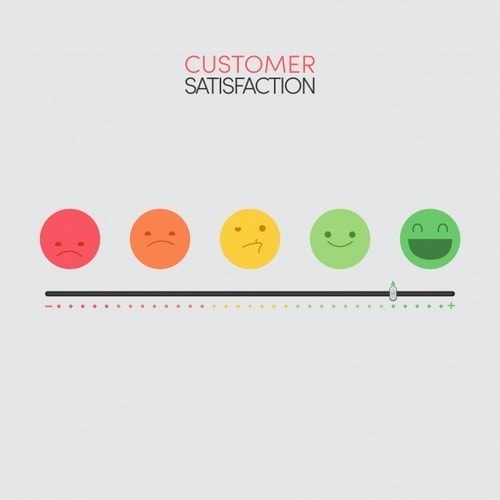Developing customer relation is the hardest challenge that an organization faces. Consumers have a direct industry influence as they are interested in various aspects like what, how, why, and where are the products and services sold.
Customer relations are the sum total a customer’s interaction with the company at various points, the buying experience, the product performance and after-sales services. The balance has shifted in favour of the consumer to a greater degree, and now it is the business organization that is dependent to a great extent on the whims of its customers for its success.
The expectations of customers have increased and to counterbalance the companies are trying to build good customer relationship via direct and indirect interaction. They are now focused on long-term relations to develop and retain customer loyalty.
Customer relations include both outbound and inbound measures taken by a company. What is the approach of a company for bettering its future chances and does it have the necessary aplomb to react positively to present issues are some important questions that need to be addressed for fostering better relations?
A company must make the customer experience count by offering them impeccable services and the best possible products. The way towards creating a good brand image is by showing the customer that you care and are always working towards bettering their experiences.
It is imperative that your efforts are seen, recognized, and appreciated by the customers so that it can ultimately lead to healthy customer relations.
Interactions matter a great deal but pay attention to the before and after aspects also. Responding positively even during the adverse situation is what an employee should be trained for.
Make sure that all your employees are working towards achieving the goal of your company, and that is a healthy customer relationship. When you have a solid customer base that is loyal to you, it will be reflected via your sales figures and profitability.
Table of Contents
Concept of customer relations
The notion of developing customer relation has been in existence since earlier times, but at that time, the balance was tilted in favour of the business entities.
With the shift in power, it has become doubly important to improve the experiences of its customers so that the brands can retain their loyalty.
It includes dealing with them politely and respectfully, answering their queries promptly and solving any related issues to their satisfaction. It is imperative to develop and maintain a mutually beneficial relationship between a customer and a brand that will extend beyond the initial purchase.
Customer relation is needed in almost all the spheres of a business organization, but it is most prevalent and active in the customer service section. It includes performing both proactive and reactive roles by the service teams.
When a company adopts a proactive role, it means that it is determined to ensure a healthy relationship with its customer that will last for a longer period.
Measures are taken to foster a deeper understanding by satisfying their evolving needs. Companies appoint customer service teams that provide necessary information about their products and services to the customers.
They also offer recent updates about offers and discounts via the help of SMS, emails, and leaflets. These actions are undertaken to create lasting impressions so that they can build a strong and loyal customer base.
When a company adopts a reactive role, it sets up a trained team that handles all the issues that customers report to the company. It includes solving related problems and responding to complaints promptly.
The companies are interested in knowing about the problems that a customer faces so that they can take steps to avoid them in the future. Hence they encourage feedback from the customers to know and solve related issues admirably.
Examples of customer relations
Go out of your way
Genuine feelings are hard to ignore, and if you care about improving your brand image, it becomes imperative to go out of your way and do so. Last year I had bought a shirt from a reputed outlet and gifted it to my boss.
After some days during general talks, I came to know that the shirt was defective. I went to my boss and asked him to give it back as I still had the receipt and would talk to the rep of that outlet. My boss told me to forget about it as he had already worn the dress for a day before he realized its defect.
But I was adamant and took back the shirt to the outlet.
When I explained the problem, the manager accepted his fault and replaced the shirt with a new one even if it was not fresh anymore. He even gift-wrapped it after learning that it was for my boss.
I gifted it back to my boss, and he was very impressed with the outlet, and from then onwards, we became its loyal customers. Everyone has heard about one item free on another item similarly because of good relations the brand managed to get two instead of one loyal customer.
Advantages of customer relations
Positive and healthy customer relation can result in several advantages for the business entity. Although it is a mutually favourable concept at the end of the day, it is the company that comes out triumphed.
This is so because it becomes possible for it to cement its strong position in such competitive times.
1) Customer loyalty
Customers have become very intelligent with time and are aware of their impact on the success of any company. They expect and want the best and will have it on their terms.
You cannot fool this new breed that is in sync with the concept of changing loyalties at the drop of a hat if circumstances are not in their favour.
Develop an excellent history if you are looking for advantages of good customer relations. When there is a strong bridge between the brand and its customer, it becomes impossible to lure them away by competitors.
Customer loyalty is a cherished commodity in these competitive times, and brands are working towards achieving it at any cost.
It is a proven fact that loyal customers are more likely to buy from you than new ones. When the customer’s experience is good, it will automatically lead to better relation and brand loyalty.
Remember, it is brand loyalty that is instrumental in generating repeated sales and consistent revenue figures.
2) Word-of-mouth publicity
The strongest advertisers of a brand are its customers. Their opinions matter a lot as they play an important role in influencing their friends and family members while making purchases.
When a customer is happy, it means that he has been treated well at the outlet and he is satisfied with both product and services. This joy gets reflected to the brand when the customer tells about his positive experience to others.
The brand has maintained good relations with only one customer, but it is paid back when the people he had recommended comes and shops with the brand they have been told about.
3) Customer retention
According to several reports, consumers stop buying from a company if they have been unable to connect with the employees of that place. An important advantage of a good customer relationship is that it helps in developing higher customer retention rates.
When companies show their willingness to address any related issues that the customers are facing the customers, in turn, pay it with their loyalty towards the brand.
Most customers are eager to do business or buy items from companies that have paid special onus on maintaining good customer relations.
Customers are willing to forgive genuine mistakes as long as you show your dedication to resolve issues efficiently and capably. Remember, increased customer retention rates have a direct impact on the profitability of a company.
4) A confidence level of the employee becomes high
When you have a steady flow of happy customers at your door, the positivity is reflected in the manners and activities of every employee. There is an added zeal in their behaviour because they want to make every customer experience count.
As customers react positively to these interactions, it generally leads to a boost in employee morale.
5) Customer Satisfaction
An important reason for good customer relations is consumer satisfaction for the brand and its products and services. If a customer is not happy, he doesn’t need to complain, but he will simply not return for further purchases.
It is imperative to build good relations so that these customers do not become one-time entrants. Maintain an open communication channel via feedbacks so that you can make necessary changes to improve the relations for the future.
Statistics have proven that marketing and advertising policy comes second after good relations for maintaining customer loyalty.
6) Profitability starts rising
An important advantage of good customer relations is that it has a direct impact on the profitability of a business. When you are offering excellent products and services, you can build good customer relations.
This increases your sales figures because you will be able to create a strong customer base that is loyal to you. Companies who tend to pay more attention to customer relations than other forms of promotional policies find themselves on the correct side of the fence.
The mouth publicity by a satisfied customer brings a new batch of customers with it. Remember an increase in sales figures will directly increase profitability figures.
Disadvantages of bad customer relation
It is a fact that relationships matter a great deal, and when they are not fulfilled as per the aspirations of the customers, then it can hurt the business.
1) Customers will leave the premises.
A customer doesn’t need to let the brand know about his bad experience in an outlet but remember actions speak louder than words. He will neither buy anything nor will he step again on the premises which did not take time to create favourable customer relations.
In these competitive times, the customer will never stick with a brand where he has experienced poor service. Remember an important disadvantage of bad customer relations is that you not only lose the customer but several others which he had bought with him via word-of-mouth publicity.
Can the brand afford bad customer relation is an important question that it should ask itself if it is not paying attention to create good relationships?
2) New customers stay away
When a person is unable to connect with the employees of a brand, he will tell about his bad experience to one and all.
An important disadvantage of bad customer relation is that it will keep potential and new customers away because they have already judged the brand via feedbacks from their friends and family and found it lacking.
People rely on word-of-mouth sayings from their near and dear ones than impersonal sources like advertising. As they will give more weight to negative feedback, they will simply stay away from the brand.
3) Dip in brand image
An important disadvantage of bad customer relations is that it can lead to negative publicity of the brand and ultimately lead to a severe dip in brand credibility and image.
Dissatisfied customers will air their grievances and express their feelings to both known and unknown persons via face-to-face conversations or posts in social media platforms.
These negative statements stay for a long time on the sites and have a lasting impact on the brand image. Once a brand becomes infamous for poor customer relations, it becomes very hard to drag itself from negative publicity to positive ones.
Remember, no one wants to be associated with a brand that cannot maintain good customer relations.
4) Profitability starts shrinking
An important disadvantage of bad customer relation is the adverse effect on the revenues and profitability of a business. The shrinking base of customers leads to poor sales figures and ultimately, less revenue.
If the company tries to increase its image by further advertisements and other promotional policies, it means an increase in overall expenditures, especially at a time when the income is shrinking. All the additional costs result in a downward spiral that could lead to a dip in the profitability figures.
5) Employees leave
It is the rats that first leave the sinking ship, and similar is the case with a brand that does not pay attention to its employees as they are the first to leave and join other companies.
It is the fault of the management that did not make its rules clear to create a favorable impression on the minds of its customers.
This leads to fewer revenues, and when the employee demands are not met because of losses, they are bound to look for elsewhere for better pastures.
If the company had reprimanded its employees at the onset when they were not maintaining good customer relations, then it would not be in this position.
How to build better customer relations
Customer relations are built by developing a stable environment where the customer is comfortable enough to trust the brand to offer him the best possible product and services that can be obtained from the market.
It promotes stability in the relationship and ultimately leads to the growth and expansion of the company. Consistent qualitative products and excellent services are the hallmarks of a company determined to win over the customers in their favour.
Every company wants to build a good and healthy customer relationship so that it can be reflected through its revenues. Maintaining a trustworthy and long-lasting relationship is not as easy as it seems.
It is not just the products that have an impact on the customers but the interaction that occurs between employees of the company and its customers.
Recruit only the best ones and offer extra training so that they can know about your company policies and the way to maintain good customer relations.
Make sure that every employee is ready to serve the customers with warmth and genuine smile even if they are not standing in their zone. Willingness is a positive trait that a customer is very much aware of.
It can scent unwanted help from far hence do not make the mistake of fooling them. Take a customer-centric approach if you are interested in creating and maintaining good customer relations.
Liked this post? Check out the complete series on Customer Management





